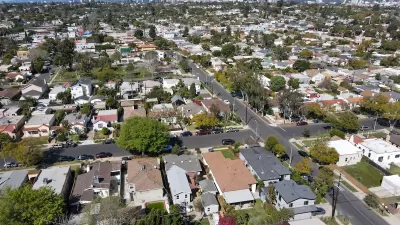Some commentators argue that even if cities allow housing supply to expand, more permissive zoning will cause land prices to increase, causing rents to rise rather than fall. This post disagrees.

The law of supply and demand suggests that if zoning becomes less restrictive, the supply of housing will expand, causing housing to become less expensive. Yet some commentators argue that new supply will not be helpful, because new housing leads to higher land prices. They reason as follows: if you can build more houses on parcel X, you can get more income from that parcel. If you can get more income from parcel X, the market value of parcel X will rise. In turn, future developers will pass the higher cost of land on to homebuyers or renters.
I find this argument unpersuasive for a variety of reasons. First, the argument leads to preposterous results. If it is really the case that new housing increases prices, then prohibiting new housing would lower prices. And if prohibiting new housing lowers price, downzoning (or better yet, demolishing the existing housing supply) would lower prices even more—obviously an absurd result. In fact, aggressive downzoning has been tried in Los Angeles. In 1960, the city was zoned to support 10 million people. By contrast, today the city is zoned for roughly its current population, which means that almost any new construction will require a rezoning. Did housing prices fall? No. In fact, rents, adjusted for inflation, have risen by 55 percent, while median renter income has grown by only 13 percent. Nor did land prices fall. Land values have increased more rapidly than home prices, from just over $86,229 per house in 1984 to $483,692 in 2014.*
Second, as a matter of theory, increased land values need not lead to increased rents: if my parcel was worth $100,000 but now is worth $200,000, I can build one $200,000 unit on my land—but I can also build two $100,000 units, or increase the housing supply by building multiple units costing less than $100,000. As long as zoning does not limit housing supply, land prices may affect the size and height of housing units rather than the price of those units.
Third, the argument would make more sense if land prices were as stable as rents, because if land prices rose and fell rapidly while rents did not, it would appear that the land price/rent link is not very strong. In fact, land prices are quite volatile: in metropolitan New York City metro area, the land price (apparently per house) swung from $99,916 at the end of 1996 to $418,592 at the end of 2006, down to under $225,000 in early 2012, and up to $250,187 in 2014.* Rent was far less volatile, generally increasing over time. Thus, it appears that the link between land prices and rents is modest.
Fourth, if new housing caused rents to increase, the regions that allowed the most new housing would be the regions with the highest rents. But permissive regions such as Dallas and Houston often have pretty low housing prices. (See here for a larger dataset.)
Finally, if increased supply caused rents to increase, rents would never go down unless a city aggressively reduced the housing supply. But in fact this has not been the case; over the past year, rents have started to go down even in some pricey metro areas- even in New York. (By an odd coincidence, construction seems to have increased).
*All data on land and home prices comes from the Lincoln Institute of Land Policy database.

Manufactured Crisis: Losing the Nation’s Largest Source of Unsubsidized Affordable Housing
Manufactured housing communities have long been an affordable housing option for millions of people living in the U.S., but that affordability is disappearing rapidly. How did we get here?

Americans May Be Stuck — But Why?
Americans are moving a lot less than they once did, and that is a problem. While Yoni Applebaum, in his highly-publicized article Stuck, gets the reasons badly wrong, it's still important to ask: why are we moving so much less than before?

Using Old Oil and Gas Wells for Green Energy Storage
Penn State researchers have found that repurposing abandoned oil and gas wells for geothermal-assisted compressed-air energy storage can boost efficiency, reduce environmental risks, and support clean energy and job transitions.

Greening Oakland’s School Grounds
With help from community partners like the Trust for Public Land, Oakland Unified School District is turning barren, asphalt-covered schoolyards into vibrant, green spaces that support outdoor learning, play, and student well-being.

California Governor Suspends CEQA Reviews for Utilities in Fire Areas
Utility restoration efforts in areas affected by the January wildfires in Los Angeles will be exempt from environmental regulations to speed up the rebuilding of essential infrastructure.

Native American Communities Prepare to Lead on Environmental Stewardship
In the face of federal threats to public lands and conservation efforts, indigenous groups continue to model nature-centered conservation efforts.
Urban Design for Planners 1: Software Tools
This six-course series explores essential urban design concepts using open source software and equips planners with the tools they need to participate fully in the urban design process.
Planning for Universal Design
Learn the tools for implementing Universal Design in planning regulations.
Heyer Gruel & Associates PA
City of Moreno Valley
Institute for Housing and Urban Development Studies (IHS)
City of Grandview
Harvard GSD Executive Education
Salt Lake City
NYU Wagner Graduate School of Public Service
City of Cambridge, Maryland






























